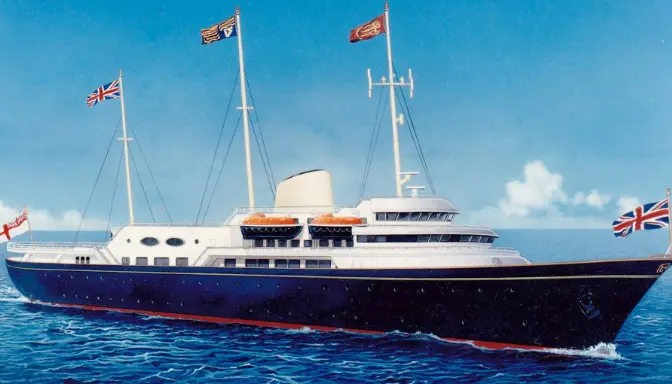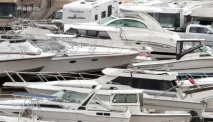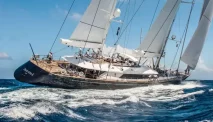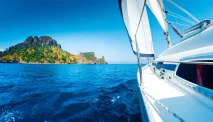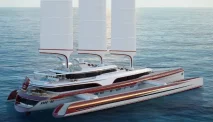Diksia.com - If you are looking for a unique and memorable experience in Edinburgh, Scotland, you might want to visit the Royal Yacht Britannia, the former floating palace of the British monarchy. This magnificent ship served the Queen and her family for 44 years, from 1954 to 1997, and travelled more than a million nautical miles around the world. Now, it is a museum ship and a visitor attraction, where you can explore its five decks and discover what life was like on board for the royals and the crew.
The Royal Yacht Britannia is one of the most iconic and prestigious vessels in the world. It served as the official residence and transport of the British royal family for over four decades, from 1954 to 1997. During its illustrious career, it travelled more than a million nautical miles, visited over 600 ports in 135 countries, and hosted countless dignitaries, celebrities, and heads of state.
Now retired from royal service, it is permanently moored at the Port of Leith in Edinburgh, Scotland, where it welcomes visitors from all over the world to explore its five decks and discover its fascinating history and secrets. In this article, we will take a closer look at the Royal Yacht Britannia, its features, its history, and its attractions.
What is the Royal Yacht Britannia?
The Royal Yacht Britannia is a ship that was specially designed and built for the British monarchy. It was the 83rd royal yacht since King Charles II acceded to the throne in 1660, and the second one to bear the name Britannia, after the racing cutter that was built for the Prince of Wales in 1893.
The ship was constructed by John Brown & Co. Ltd in Clydebank, Dunbartonshire, and launched by Queen Elizabeth II on 16 April 1953. It was commissioned on 11 January 1954, and sailed on its maiden voyage from Portsmouth to Malta on 14 April 1954.
The ship was designed with three masts, a 412-foot (126 m) length, a 55-foot (17 m) beam, a 15-foot (4.6 m) draught, and a 12,000-horsepower (8,900 kW) steam turbine engine that could propel it to a maximum speed of 21.5 knots (39.8 km/h; 24.7 mph). It had a range of 2,400 nautical miles (4,400 km), and could accommodate up to 250 guests and 271 crew members.
The ship was also equipped with various features that made it suitable for royal service, such as:
- A state drawing room, a state dining room, a sun lounge, a veranda deck, and a royal deck tea room for entertaining guests and holding receptions
- A royal suite, consisting of separate bedrooms for the Queen and the Duke of Edinburgh, a dressing room, a sitting room, and a private sun deck
- A royal household, comprising the offices and quarters of the royal staff, such as the private secretary, the equerry, the ladies-in-waiting, the press officer, and the chef
- A sick bay, a dentist’s surgery, a cinema, a swimming pool, a gymnasium, a laundry, a garage, and a post office for the convenience and comfort of the royals and the crew
- A helicopter landing platform, a sailboat davit, and a motorboat crane for transporting the royals and their guests to and from the ship
- A hidden compartment, containing a set of lead-lined boxes that could store the royal jewels in case of emergency
- A capability to be converted into a hospital ship in time of war, although this was never used
- A contingency plan to serve as a refuge for the Queen and the Duke of Edinburgh in the event of a nuclear war, although this was also never used.
What is the history of the Royal Yacht Britannia?
The Royal Yacht Britannia had a long and distinguished history of serving the British monarchy and representing the United Kingdom around the world. It was involved in many significant events and occasions, such as:
- The Commonwealth tour of 1953-1954, when the Queen and the Duke of Edinburgh visited 13 countries and 36 ports in six months, covering over 40,000 miles.
- The Suez Canal crisis of 1956, when the ship evacuated the British High Commissioner and his staff from Egypt.
- The first royal visit to the Soviet Union in 1973, when the ship carried the Queen and the Duke of Edinburgh to Leningrad and Moscow, where they met with President Leonid Brezhnev and other Soviet leaders.
- The Silver Jubilee of 1977, when the ship led a flotilla of over 160 vessels along the River Thames, as part of the celebrations of the Queen’s 25th anniversary on the throne.
- The handover of Hong Kong in 1997, when the ship carried the Prince of Wales, the Governor of Hong Kong, and other British officials to the ceremony that marked the end of British rule and the transfer of sovereignty to China.
The ship also hosted many famous and influential people, such as:
- Winston Churchill, who sailed on the ship to the funeral of King George VI in 1952, and to the coronation of Queen Elizabeth II in 1953.
- Dwight D. Eisenhower and Nikita Khrushchev, who were entertained by the Queen and the Duke of Edinburgh on board the ship during their visits to the United Kingdom in 1959 and 1960, respectively.
- Nelson Mandela, who was welcomed by the Queen and the Duke of Edinburgh on board the ship during his state visit to the United Kingdom in 1996.
- Princess Diana, who joined the royal family on several occasions on board the ship, such as the honeymoon of the Prince and Princess of Wales in 1981, and the royal tour of Italy in 1985.
- The Beatles, who received their MBEs from the Queen on board the ship in 1965, and later performed a concert for the royal family and the crew.
The ship also witnessed many personal and intimate moments of the royal family, such as:
- The birth of Prince Andrew in 1960, who was the first child born to a reigning monarch since Queen Victoria.
- The wedding of Princess Anne and Captain Mark Phillips in 1973, who spent their honeymoon on board the ship.
- The funeral of Lord Mountbatten in 1979, who was killed by an IRA bomb on his boat in Ireland. The ship carried his coffin and his family to the funeral service in Westminster Abbey.
- The divorce of the Prince and Princess of Wales in 1996, who had their final meeting on board the ship before announcing their separation.
The ship was decommissioned on 11 December 1997, after 43 years of service. The Queen, the Duke of Edinburgh, and other members of the royal family attended a farewell ceremony in Portsmouth, where the Queen shed a tear as she said goodbye to the ship.
A Brief History of the Royal Yacht Britannia
The Royal Yacht Britannia was the 83rd royal yacht of the British monarchy, and the second one to bear the name. The first Britannia was a racing cutter built for the Prince of Wales in 1893. The current Britannia was built at the shipyard of John Brown & Co. Ltd in Clydebank, Dunbartonshire, and launched by Queen Elizabeth II on 16 April 1953. It was commissioned on 11 January 1954, and sailed on its maiden voyage from Portsmouth to Malta, where it carried Prince Charles and Princess Anne to meet the Queen and the Duke of Edinburgh at the end of their Commonwealth tour.
Britannia was designed with three masts, a 412-foot (126 m) length, a 55-foot (17 m) beam, and a 15-foot (4.6 m) draught. It had a tonnage of 5,769 gross tons, and a speed of 21.5 knots (39.8 km/h). It was powered by two Pametrada steam turbines, and had a range of 2,400 nautical miles (4,400 km). It could accommodate 250 guests and 21 officers and 250 Royal Yachtsmen as crew. It also had a detachment of Royal Marines and a contingent of Royal Marines Band members on board.
Britannia was designed to be converted into a hospital ship in time of war, although this capability was never used. In the event of a nuclear war, it was intended for the Queen and Prince Philip to take refuge aboard Britannia off the north-west coast of Scotland.
Britannia served the Queen and her family for 44 years, and was used for official visits, state occasions, diplomatic receptions, royal holidays, and honeymoons. Some of the most notable events that took place on board Britannia include:
- The signing of the first trade agreement between the UK and China in 1974.
- The evacuation of British nationals from Aden during the Aden Emergency in 1967.
- The hosting of US Presidents Dwight D. Eisenhower, Gerald Ford, Ronald Reagan, and Bill Clinton.
- The celebration of the Queen’s Silver, Golden, and Diamond Jubilees in 1977, 2002, and 2012.
- The honeymoon of Princess Margaret and Antony Armstrong-Jones in 1960, Princess Anne and Captain Mark Phillips in 1973, Prince Charles and Princess Diana in 1981, and Prince Andrew and Sarah Ferguson in 1986.
Britannia was decommissioned on 11 December 1997, in a ceremony attended by the Queen, the Duke of Edinburgh, and 12 members of the royal family. The Queen shed a tear as she bid farewell to her beloved yacht, which was the last in a long tradition of British royal yachts dating back to 1660 and the reign of Charles II.
The Royal Yacht Britannia as a Visitor Attraction
Since 1998, Britannia has been berthed permanently at the Port of Leith in Edinburgh, Scotland, where it is a visitor attraction and a charity. It is owned and operated by The Royal Yacht Britannia Trust, which aims to conserve and display the ship for the benefit of the public. Britannia attracts over 300,000 visitors each year, and has been voted as the UK’s No. 1 attraction by TripAdvisor in 2020.
Visitors can tour all five decks of Britannia, and see how the royals and the crew lived, worked, and entertained on board. Some of the highlights of the tour include:
- The State Apartments, where the Queen and the Duke of Edinburgh hosted dignitaries and celebrities, and where they had their private quarters. The apartments are decorated with elegant furniture, paintings, and photographs, and feature personal touches such as the Queen’s writing desk, the Duke’s naval charts, and a baby grand piano.
- The Sun Lounge, where the Queen enjoyed reading and relaxing, and where she had her afternoon tea. The lounge has a panoramic view of the sea, and is filled with plants and flowers.
- The Royal Deck Tea Room, where visitors can enjoy a selection of homemade soups, sandwiches, cakes, and speciality teas and coffees, served on the original Britannia china. The tea room also offers stunning views of the waterfront and the Edinburgh skyline.
- The Bridge, where the Captain and the officers navigated and steered the ship. The bridge is equipped with various instruments, controls, and communication devices, and displays the ship’s original wheel and bell.
- The Engine Room, where the engineers and stokers maintained and operated the ship’s machinery. The engine room is immaculately clean and polished, and showcases the two Pametrada steam turbines, the electric generators, and the boilers.
- The Sick Bay, where the ship’s doctor and nurse treated the crew and the guests for any illnesses or injuries. The sick bay has a dispensary, a surgery, and a ward, and displays some of the medical equipment and supplies used on board.
- The Laundry, where the laundrymen and seamstresses washed, dried, ironed, and mended the clothes and linens of the royals and the crew. The laundry has a washing machine, a dryer, an ironing board, and a sewing machine, and exhibits some of the uniforms and garments worn on board.
- The Crew’s Quarters, where the Royal Yachtsmen and the Royal Marines slept, ate, and socialised. The quarters are divided into messes, cabins, and dormitories, and reflect the different ranks and roles of the crew. The quarters also feature a cinema, a bar, and a gymnasium, where the crew enjoyed their leisure time.
In addition to the tour, visitors can also experience some of the special events and activities that Britannia offers, such as:
- The Evening Tours, where visitors can explore the ship after hours, and enjoy a glass of champagne and a slice of the Britannia fudge in the State Drawing Room.
- The Royal Yacht Britannia Gift Shop, where visitors can find a range of souvenirs and gifts, such as Britannia china, jewellery, clothing, books, and toys.
- The Royal Racing Yacht Bloodhound, where visitors can see and sail on the 1930s yacht that belonged to the Queen and the Duke of Edinburgh, and that was used to teach Prince Charles and Princess Anne how to sail.
- The Fingal Hotel, where visitors can stay in a luxury floating hotel that was formerly a lighthouse tender, and that is moored next to Britannia. The hotel has 23 cabins, a restaurant, a bar, and a ballroom, and is decorated with nautical and Art Deco themes.
The Royal Yacht Britannia is one of the most popular and acclaimed attractions in the United Kingdom. It has been voted as the best UK attraction by TripAdvisor in 2023, and has received over five million visitors since it opened in 1998.
Why You Should Visit the Royal Yacht Britannia
The Royal Yacht Britannia is more than just a ship. It is a floating palace of history and elegance, where you can learn about the lives and stories of the British monarchy and their loyal crew, and where you can enjoy a taste of royal hospitality and service. Whether you are a fan of the royals, a lover of ships, or a seeker of adventure, you will find something to fascinate and delight you on board Britannia. So, don’t miss this opportunity to visit one of the most iconic and prestigious attractions in the UK, and book your tickets online today. You won’t regret it.
The Royal Yacht Britannia is more than just a ship. It is a symbol of the British monarchy, a witness of history, and a treasure of culture. It offers a unique and unforgettable experience for anyone who wants to learn more about the royal family, their lifestyle, their travels, and their achievements. It is a floating palace of history and elegance, that deserves to be seen and appreciated.
